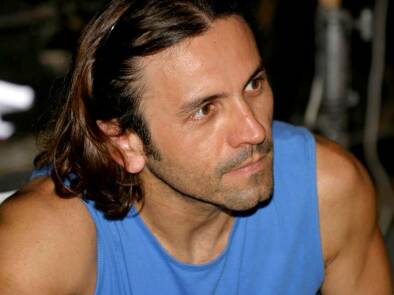 Halder Gomes is a 4th degree black belt and blue belt in Brazilian Jiujitsu. He’s also a graduate in business administration with an MBA in Marketing, from the University of Fortaleza – so he can write your company a plan, then kick your ass if you don’t follow it. :-) However – and undoubtedly of more relevance to our current location, he’s also the director of Sunland Heat, what may be the first locally-produced action-heroine film from Brazil. In between jetting to festivals with his short film Cine Holiúdy – the Good Guy Against the Bad Guy, and attending the American Film Market, he talked to girlswithguns.org about the movie.
Halder Gomes is a 4th degree black belt and blue belt in Brazilian Jiujitsu. He’s also a graduate in business administration with an MBA in Marketing, from the University of Fortaleza – so he can write your company a plan, then kick your ass if you don’t follow it. :-) However – and undoubtedly of more relevance to our current location, he’s also the director of Sunland Heat, what may be the first locally-produced action-heroine film from Brazil. In between jetting to festivals with his short film Cine Holiúdy – the Good Guy Against the Bad Guy, and attending the American Film Market, he talked to girlswithguns.org about the movie.
What came first, martial arts or film-making?
Movies brought me to martial arts, and martial arts brought me to the movies. Actually, martial arts films came first. The first movie I ever saw was in the martial arts genre back in the ’70s. The theater was so precarious – as was the print! – but it still had magic (and inspired my second film). After that screening I decided that I wanted to be a black belt and make movies, but I was only about six years old, just too young to figure out how to put those fantasies together. At that time I lived in a small town in the middle of nowhere in the country side of Brazil, but in spite of this, I that kept the dream in my mind.
Years later, in 1984, when I was doing an exchange program in Drayton Plains, Michigan, I did my first taekwondo class. It was funny, but the reason behind that was absolute boredom. A strong snow storm meant I had to stay in the house with my American family – not speaking any English, I spent time looking at the yellow pages, and I saw a taekwondo logo. When the storm ended, I went for a trial class. I believe that storm was a sign to put those dreams together – it was also just at the time that The Karate Kid was out.
When I came back to Brazil, I met André Lima, who became my taekwondo master; he was also a dreamer, and after the classes we used to talk for hours about going to Hollywood, working in films, etc. If you say that in the US, fine, but where we came from, we were absolutely lunatics! In 1991 André went to live in LA, and he started doing stunts in martial arts films for Philip Rhee, Art Camacho, Don ‘The Dragon’ Wilson, etc. That’s where I came along: Art Camacho was a great help, giving me bit parts in his films, and being very enthusiastic about teaching me the film making process.
 Where did the idea for the film come from?
Where did the idea for the film come from?
Chatting on the sets of martial arts films. My city, Fortaleza, is a beautiful location: a great variety of natural scenarios, sun with no clouds for 6 months straight, fabulous beaches, etc. The city of Fortaleza has been film-friendly, since the ’40s, when Orson Welles spent a long time shooting his never finished It’s All True, but until Sunland Heat, no action films were done there – breaking this barrier was a matter of honor.. I had all those ideas, but no script. So I went to the local film school and placed a note on the hall saying that I was looking for a script writer with a story for an action/martial arts film. I also wanted to show the nice side of Brazil. Most of the movies only show “favelas” – misery, etc. I’m not trying to hide our social problems, but Brazil is not only about that.
What is the Brazilian film industry like?
Our industry is growing, but it’s very different than in the US: it’s all based on tax incentives. You have a project that is submitted to the Brazilian National Cinema Agency. If your project gets approved you are allowed to sell stock bonds to capitalize your budget – companies can buy these stocks, deducting taxes and becoming co-owner of the film. It looks simple, but isn’t. There are very complex bureaucracy issues, plus, it’s still the government’s money anyway. The marketing departments of these companies make the decision on where to invest, but of course only want the films that do well in the box office, and also get as much as possible exposure on the major media, which makes the competition very tough for independents. We don’t have much to offer to them, except our work and stories. We have to fight the majors for the same “food”.
There’s another way of investment, which also is very good for the majors. They are obliged to invest on local production – part of the tax-deductible profits sent to their headquarters in US. But it’s still the same thing: the money barely gets to independents, instead they use it for making co-productions with other big companies. Every state has their own tax incentives as well, and that’s where we fit in, even though, in short, if the Federal Government “pulls the plug”, our industry is over.
How did you go about getting investors?
It was crazy. I raised part of the funds through that local tax incentive program, which was just beginning. I had to spend many, many hours with accountants explaining how the legislation works, and ended up visiting 139 companies within 3 months – only a postman can break my record! – many of them, more than ten times. Out of all those, 13 said “Yes”. The funny thing was, for some of these who said yes, their words after closing the deal were, “You’re crazy, dude – so am I. You have my support, go get into the details with the accounting department”. But the money came little by little, in “homeopathic doses”. Here’s what’s interesting about my investors: I have a shoe store company, a juice company, a jeans textile, sunglasses store, construction material shop, electricity company, telephone company, and so it goes. It’s not easy to sell a film idea to people that have no clue about the entire process.
 Why did you decide to have a female lead?
Why did you decide to have a female lead?
The story that the writer had in mind had a female lead, and I had no objection at all, As a matter of fact, I really liked the idea, especially because the character was not stereotyped. As a matter of fact, my next two scripts have female leads. It’s very easy working with them on set. They listen better, and are more patient! I tried to interfere in the writer’s creative process as little as possible, however, when you have to direct and produce at the same time with a tight budget and schedule, it’s impossible not to have “production versus directing versus writer”. It’s quite normal, but you have to fragment yourself: in the end the lack of time and money wins, so you have to give up shots or full pages of the script.
Did you have specific actors in mind?
Yes, I even had a letter of intent from Cynthia Rothrock. I also had André Lima in mind as a bad guy (which he played), Mathias Hues, Athena Massey. But the entire process took so long due to many problems along the way, than I had to re-think about everything, and decided to open up casting for most of the characters.
Was it a lengthy casting process?
As a matter of fact the casting went fast. I did a two weeks ad in the Back Stage West, and it rained resumés and headshots, about 3,000 in total. I cut to 25 of each character and than started casting. It was a hard time to do it: 9/11 had just happened, the world was still a little bit confused, and many people were scared to death to leave their homes. One of the things that I had also to see was, if the ones I wanted had travelled across borders before. I didn’t want someone to chicken out or panic, because of some little tropical mosquitos or insects, for example! André Lima is an old friend, so is JJ Perry (both world-class taekwondo champions and stunt-men) and they would be the action pillars of the film. For the acting I had the experience of Jay Richardson and Laura Putney, and for the action and acting, I had the versatility of Alex.
Why did you decide to take a role yourself?
All the bit parts that I did in US martial arts films were getting my butt kicked, so, since it was my movie, I wanted to kick some ass and do a nice fight scene with JJ. Unfortunately I had to have anterior cross ligament surgery a little before the film; I never had enough time to heal and perform, which brought me back to where I started: getting my butt kicked! After that I didn’t care about being in front of the cameras anymore. I really like being involved with creation. In my second film, I only have my face on a poster that stands in front of a movie theater.
 It was Alex Van Hagen’s first film. Did you have qualms about putting a screen novice in the lead?
It was Alex Van Hagen’s first film. Did you have qualms about putting a screen novice in the lead?
Not at all. Actually that was the spirit of the film. My first film, Alex’s first lead role, JJ Perry and André Lima’s first major part, the director of photography’s first feature, etc. Alex did a great job. Her role was not easy. It required very intense acting, especially in the final scene and during the fight in the gym. She prepared herself for that by taking acting classes and adjusting her kickboxing style to taekwondo and mixed martial arts. The film gave lots of opportunities and revealed many talents behind the cameras as well. To tell you the truth, I think producers in the US don’t use JJ appropriately, by not giving him major roles. He can act, and his fighting skills are fantastic. Labeling him as a “stunt man”, is a big mistake, though he is one of the best. He has a real star profile.
As a rookie feature director, how did you feel the first day on set? And overall, was it what you expected?
Absolutely calm. I had no obligation to make a masterpiece, nor the conditions to do it. My sole concern was to get all the shots done by end of day: we only had 4 weeks, due to other commitments for the actors. As a matter of fact, shooting was much easier than post – it’s a big help if you have a good production manager. Basically, it was like I used to see on other sets: people go crazy, yell at each other, hurry, rush and hustle, then hugs and kisses after the wrap shot. But to tell you the truth, filming in Brazil is more fun! Jokes crack people up all the time from everywhere, making the set more relaxed.
It looks like it was mostly done on location. Did that pose any special problems?
Yes, it was all done on location and we had many problems, epecially with sound. Brazil is a very festive country, and there’s always some wild, wasted dude with their stereo in the car at the highest volume. For the scene of Jennifer waking up, there was the sound of a dog barking, and we couldn’t find where it came from – it took us a long time until we found the house! And at the final scene where Jackie gets killed, there was a train route that would pass right by us every five minutes.
Were the action scenes planned out in advance, or created on the day?
I had some initial frames outlining the main action on storyboards – you can see some of them on my web site, in the “cinema” section. From these, JJ Perry could develop the action and fight scenes; we’d discuss it, and since he works fast on his creations, we could practice them right away. But the locations did also play a part in the decisions for certain shots.
You said that a lot had to be removed from the script. Can you tell us more about what was taken out?
Mostly, these were scenes that gave more information about the characters. I also had to remove a car chase on the sand dunes and most of the scenes of the parallel plot, about the casino money that’s been stolen by Laura Putney’s character. The first scene was much longer in the script with a lot more action and LA exterior shots. These cuts were made at the writing stage. During the shoot we had to cut a few things due to production problems along the way: we shot in the rainy season, so had to be very fast, and sometimes instead of covering with many shots, we had to shorten quickly the entire shooting schedule of the day.


It’s a dirty job, but someone’s got to do it.
Laura Putney gets bloodied up for Sunland Heat
After the movie was filmed, I had the option of editing in a more linear way (which I did in a first cut), but then decided to do something different from the usual for action films. I couldn’t afford to have that much action, so I had to keep the attention of the viewer in between these scenes – making the story full of U-turns was the way I found to do it. In the end it split opinions about the structure of the storyline, and that was the intention, otherwise it would have been something made to formula.
These days, it often seems easier to make a film than to find distribution for it. How hard was it for Sunland Heat?
It’s not easy, but I’m extremely persistent, very patient and I would say obsessive. A film is a product like any other, and you have to position yourself in the right niche. When I had the film in the can, I went to the American Film Market and researched what companies had the right profile for my film. After selecting these distributors, I did a check list based on point scores from 0 to 10 – time in the business, references, how they treat you when you approach, professionalism, presence in the major markets, how long their days were at the AFM, etc. It seems crazy, but it’s your film; given everything you had to go through, you don’t want to give it to anyone, just to say “I have a distributor”. After all, you have investors to pay back and finally get paid! Then I started sending screeners: I sent them to the top 3 first, and the #1 on the list, Artist View Entertainment, was the one with which we made the deal.
 In Brazil, it was different. When doing post production on Cine Holiúdy, I left a screener at a distributor (Casablanca Filmes), part of the same company as the lab. The film was in their drawer until its premiere in our State film festival. That was a sellout (right): more than 400 people couldn’t get in, causing security problems, and the festival organizers needed other screenings. By coincidence, the distributor’s publisher was there – so were the press and one very respected film critic, Kleber Mendonça Filho, published his review with a headline on the cover of Universo Online, the number one Internet magazine in Brazil. The next day the distributor pulled the film out of their drawer, called me and we made a deal memo. The next week, others did too, including one major distributor.
In Brazil, it was different. When doing post production on Cine Holiúdy, I left a screener at a distributor (Casablanca Filmes), part of the same company as the lab. The film was in their drawer until its premiere in our State film festival. That was a sellout (right): more than 400 people couldn’t get in, causing security problems, and the festival organizers needed other screenings. By coincidence, the distributor’s publisher was there – so were the press and one very respected film critic, Kleber Mendonça Filho, published his review with a headline on the cover of Universo Online, the number one Internet magazine in Brazil. The next day the distributor pulled the film out of their drawer, called me and we made a deal memo. The next week, others did too, including one major distributor.
How has the film been received?
There were many different point of views, like any other film. Some very respected critics in Brazil wrote good reviews about it, pointing out where the movie did well and where not. As for the audience, some liked it because it was not the usual kind of script, some didn’t because they wanted something simpler with more action. Some liked it because there weren’t many gun shots, some didn’t because there weren’t enough. Some liked it because the lead actress had her fragilities as a human being, some didn’t because they wanted something like a superwoman! A good way is to compare reviews from different writers, with other equivalent films. By doing that, I would say it was not so bad for a first film. Cinescape gave a B+, Girlswithguns 3.5/5, Cinemascopio (Brazil) 2.5/5, Yourvideostoreshelf 5/10, ATN zone 2.5/5, and so on.

Halder being interviewed by Jô Soares on Programa do Jô – Brazil’s version of Jay Leno
What do you think about Brazilian cinema at the moment?
It’s growing, in spite of the complete dependency on tax incentives, but we still have a lot to do – especially to get better financial conditions for independents and distributors. Our Ministry of Culture plays an important part for new film makers, by creating funds for shorts, docs, and low budget films; the competition is tough, but it’s what we have. There was a time not long ago, when Brazilians were concerned about going to the theater to see our movies, because we had many problems, technically speaking. Now that’s history: the number one blockbuster this year in Brazil is a local movie, 2 Filhos de Francisco, and I believe it’s only a matter of time before a Brazilian film wins the Oscar for best foreign picture – we came close with City of God and Central Station. New talents emerge all the time: unfortunately, due to the low amount of money in the market, the percentage of good stories that are left to lie in a drawer is higher than in other places.
Looking at the finished product now – and trying to be unbiased! What do you think of it? Would you do anything differently if you had the chance to start over?
I see it in two different ways. One is, what is the film like compared to similar ones, by genre and budget? – and I’m very happy with it. The other way is, comparing it to the first film of known directors, and how they’ve improved. By that measure, after all is said and done, I’m satisfied. Being satisfied with the product doesn’t mean that I’m satisfied with myself. I’ve seen many great directors’ first movies, and their talent is like marble, waiting to be sculpted – sometimes rough, some times naif and primitive – but it’s there. Of course I’m comparing first films made under the same circumstances. I can’t forget where I came from, and that before Sunland Heat, I had never directed or produced even a wedding video. But you must learn the lessons from your own experiences; I’ve learned mine and I do know what I have to improve. I believe I did a bit in my second film; the rain of awards and prizes from film festivals supports that!
My biggest lesson is not to give in over what you want. After working on the production teams of top Hollywood directors, I’ve seen that they get their shots no matter what – and by seeing the final result, most of the time you agree that they were right about being obsessive about it. Looking back, after the film is made, you think many things: happy or lucky to do something this way, regretting not doing it that way. But when you’re there as director, producer, executive producer, production designer, stunt-man, actor, signing checks, etc, you can’t see it as clearly as on the screen, plus things move very fast.
No matter what happens in the future, this will be my most important film, even if I win an Oscar. Being very honest, if I didn’t know what I do now, I don’t know if I would have done anything different. But given the experience I have today, certainly I would take the time to rewrite the script, and have at least a couple of days with my cast for workshops. It’s hard to say that I could do much else different, given the same conditions and being involved in so many ways. I would do the editing different, like at the beginning of the film; I’d have done more pick up shots and have more flashback inserts; and I’d cut it the way I see now.
 Since then, you made Cine Holiúdy – the Good Guy Against the Bad Guy. Why did you decide on a short film rather than another feature?
Since then, you made Cine Holiúdy – the Good Guy Against the Bad Guy. Why did you decide on a short film rather than another feature?
Doing a feature is great, but I didn’t want to repeat the same experience right after. I wanted to do something faster and cheaper, however with great impact. I see the short film as a fight that ends in a knockout, while a feature is decided on points. And raising funds for a feature can take too long. To tell you the truth, I loved doing Cine Holiúdy, it was a script for which I had great passion, and that helps to tell a story of the time and place where I grew up – I’m a nostalgic person, and would say it’s autobiographical.
It turned out to be one of the most successful short films in festivals in Brazil over the past year. It won many best film awards, as well as other categories, and has been screened in festivals such as Raindance in London, and in Romania, Germany, Austria, Switzerland, etc. It has even been used by executives in Brazil as a tool and foundation, for business speeches and seminars on initiative, solving chaotic situations, creativity, agility, etc!
What are your next plans? Are you planning to stay in the action genre?
In between features, I’ll keep doing shorts for sure – as a matter of fact, my very next project is a short documentary (with an extended 50-minute TV version) about soccer fans in Brazil, with which I won a State writers’ funds contest. The good thing about Cine Holiúdy, is that I have a great “trailer” for a feature-length version and that helps find investors. I see shorts that way, as a bridge to bigger projects.
It’s hard to make plans in Brazil, but I have many projects rolling – the first to get financed will be made first! Another feature idea is also being shown to potential investors, called Sweet Dreams Cinderella. It’s an action/drama story about girls from Fortaleza that go to Europe with promises of decent work, and end up as sexual slaves – it’s based on true stories. There’s also the feature version of Cine Holiúdy, a psycho-thriller short film, and more scripts that I’m writing.
As for Sunland Heat, the film so far has been released in 12 countries, including USA, Japan and UK. In Brazil it will be re-released by Paramount Pictures, along with a comic book as a prelude, briliantly made by local artists. But I don’t want to stay only in the action genre – I like telling stories, no matter what the genre is. Doing a comedy like Cine Holiúdy, that worked for many different cultures in many countries: it definitely made me more confident for all my future ideas.
[Many thanks to Halder Gomes for making the interview – our first! – such a pleasure to do, and assisting with photos too.]





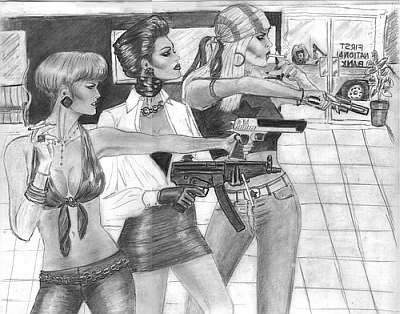
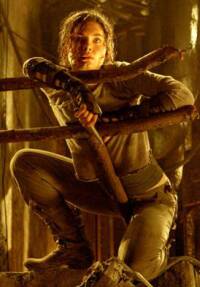 The Chronicles of Riddick. A survivor from the previous film, Pitch Black, “Jack” turned out to be a young girl, who disguised her sex in order to survive. Five years later, she’s now played by Alexa Davalos (right), and her character, who has taken bad-ass Riddick as a role-model, is now imprisoned in a subterranean jail on the aptly-named planet of Crematoria. Her favourite game is, “Who’s the best killer?”; when she’s accompanying Riddick, opportunities to play are numerous.
The Chronicles of Riddick. A survivor from the previous film, Pitch Black, “Jack” turned out to be a young girl, who disguised her sex in order to survive. Five years later, she’s now played by Alexa Davalos (right), and her character, who has taken bad-ass Riddick as a role-model, is now imprisoned in a subterranean jail on the aptly-named planet of Crematoria. Her favourite game is, “Who’s the best killer?”; when she’s accompanying Riddick, opportunities to play are numerous.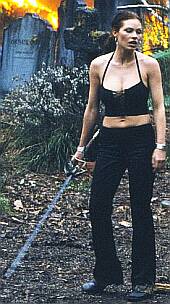 House of the Dead. This critically slated video-game conversion offers three supporting action heroines behind its extremely dull hero. There’s his girlfriend, fencing mistress Alicia (Ona Grauer, left), Coastguard officer Casper (Ellie Cornell), and Liberty, an Asian-American in a patriotic outfit who (like all Asians) knows kung-fu. Sadly, two out of three don’t make it to the end.
House of the Dead. This critically slated video-game conversion offers three supporting action heroines behind its extremely dull hero. There’s his girlfriend, fencing mistress Alicia (Ona Grauer, left), Coastguard officer Casper (Ellie Cornell), and Liberty, an Asian-American in a patriotic outfit who (like all Asians) knows kung-fu. Sadly, two out of three don’t make it to the end.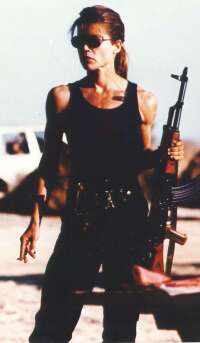 Terminator 2: Judgement Day. The character of Sarah Connor (right) underwent a startling transformation between original and sequel – a wimpy fraidy-cat became a pumped, focused, extremely capable action heroine, intent on defending her son. Though she ends up relying on Arnie in the final steel-mill battle (which includes Linda Hamilton’s twin sister), she definitely gives the T-1000 her best shot. Several of them, in fact. The next logical step followed, in
Terminator 2: Judgement Day. The character of Sarah Connor (right) underwent a startling transformation between original and sequel – a wimpy fraidy-cat became a pumped, focused, extremely capable action heroine, intent on defending her son. Though she ends up relying on Arnie in the final steel-mill battle (which includes Linda Hamilton’s twin sister), she definitely gives the T-1000 her best shot. Several of them, in fact. The next logical step followed, in 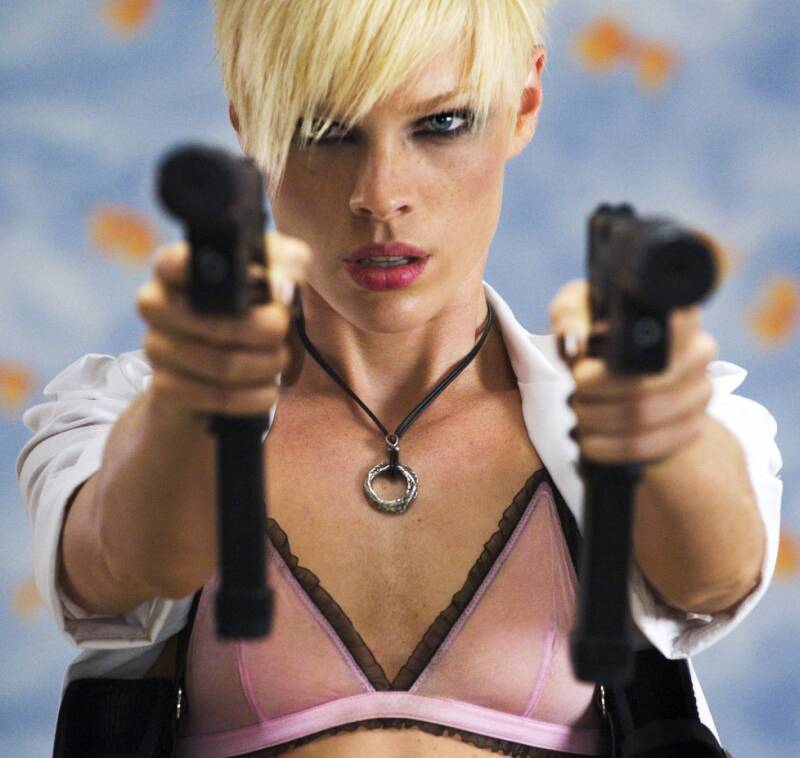 The Transporter 2 – Having thoroughly enjoyed The Transporter, the sequel was already well on the radar. But what we didn’t expect was some serious GWG action, with the psychotic henchwoman (Katie Nauta, pictured left) going berserk in a doctor’s office with
The Transporter 2 – Having thoroughly enjoyed The Transporter, the sequel was already well on the radar. But what we didn’t expect was some serious GWG action, with the psychotic henchwoman (Katie Nauta, pictured left) going berserk in a doctor’s office with 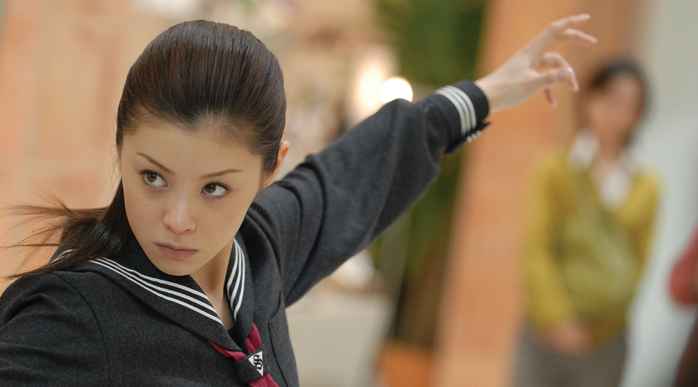
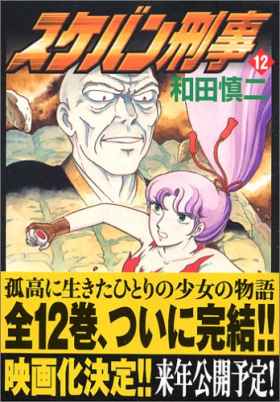 Rarely has the phrase, “Only in Japan,” ever been more appropriate. It’s not just the notion of a delinquent schoolgirl, taken in by the government and turned into a secret-agent of sorts. That, alone, is odd, but not particularly memorable. No, it’s that her weapon of choice is a
Rarely has the phrase, “Only in Japan,” ever been more appropriate. It’s not just the notion of a delinquent schoolgirl, taken in by the government and turned into a secret-agent of sorts. That, alone, is odd, but not particularly memorable. No, it’s that her weapon of choice is a  This appears to be episodes 34-36 of the second series, and having watched them, I feel I can convincingly state, with little fear of contradiction, that I have little or no idea what is going on. #34 takes place mostly in the woods, with Saki apparently possessed by something that causes her to attack her friends. Also roaming the woods is a samurai, and another schoolgirl, who possesses fangs, and leaps to the attack accompanied by cat noises. There is a fair amount of largely-unconvincing fighting, ending when Saki has her memory jogged by a small trinket, apparently breaking the curse placed upon her. To say any more would probably be…unwise.
This appears to be episodes 34-36 of the second series, and having watched them, I feel I can convincingly state, with little fear of contradiction, that I have little or no idea what is going on. #34 takes place mostly in the woods, with Saki apparently possessed by something that causes her to attack her friends. Also roaming the woods is a samurai, and another schoolgirl, who possesses fangs, and leaps to the attack accompanied by cat noises. There is a fair amount of largely-unconvincing fighting, ending when Saki has her memory jogged by a small trinket, apparently breaking the curse placed upon her. To say any more would probably be…unwise.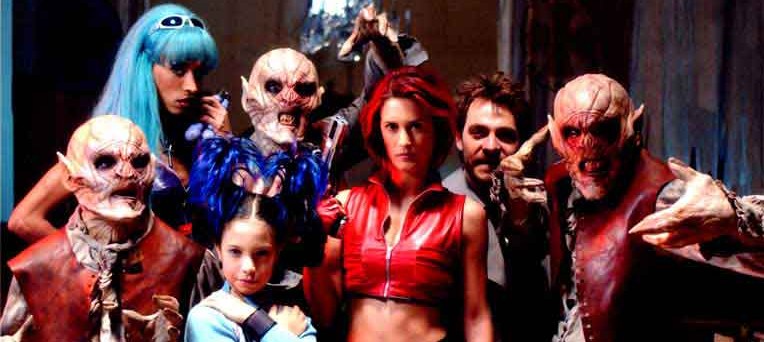 First, some background. This interview was originally conducted by email all the way back in April 2006, with the director of
First, some background. This interview was originally conducted by email all the way back in April 2006, with the director of 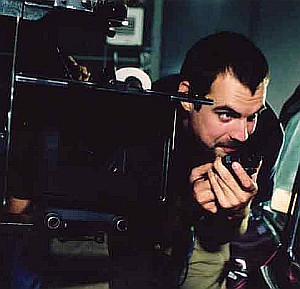 Were you a big movie-fan when you were young? What was the first film to make an impression on you?
Were you a big movie-fan when you were young? What was the first film to make an impression on you?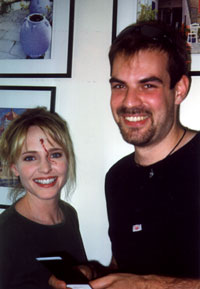 Your first film was the short, The All New Adventures of Chastity Blade. How did this come about?
Your first film was the short, The All New Adventures of Chastity Blade. How did this come about?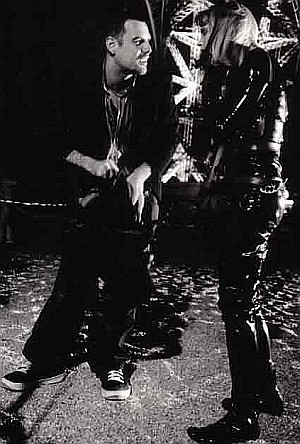 Where did the core idea for Bloody Mallory come from?
Where did the core idea for Bloody Mallory come from?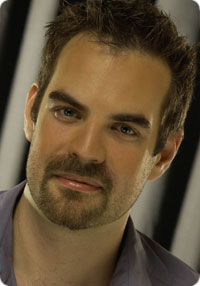 Organized religion doesn’t exactly come out of this looking good – not least the Pope! How much does this reflect your own feelings?
Organized religion doesn’t exactly come out of this looking good – not least the Pope! How much does this reflect your own feelings?
 Few girls with guns creations have been as cross-media as Kei and Yuri, Haruka Takachiho’s Dirty Pair. Initially a collection of novels which began in 1979, they then became a TV show, a straight-to-video feature, a theatrical film, a straight-to-video series, hopped the Pacific to become an American-produced graphic novel, then returned to Japan to become another three video series, some “Stereo Drama” CDs, and two volumes of manga. Most recently, Lovely Angel: Kei and Yuri debuted on radio in Osaka in October 2006; a second series was released a year later, relocating Kei and Yuri to the year 1791 as student ninjas. Which is, at least, different. As we also had a translation of the first novel released in America, September 2007, the Dirty Pair bandwagon shows little sign of stopping, as the characters head towards their thirtieth birthday.
Few girls with guns creations have been as cross-media as Kei and Yuri, Haruka Takachiho’s Dirty Pair. Initially a collection of novels which began in 1979, they then became a TV show, a straight-to-video feature, a theatrical film, a straight-to-video series, hopped the Pacific to become an American-produced graphic novel, then returned to Japan to become another three video series, some “Stereo Drama” CDs, and two volumes of manga. Most recently, Lovely Angel: Kei and Yuri debuted on radio in Osaka in October 2006; a second series was released a year later, relocating Kei and Yuri to the year 1791 as student ninjas. Which is, at least, different. As we also had a translation of the first novel released in America, September 2007, the Dirty Pair bandwagon shows little sign of stopping, as the characters head towards their thirtieth birthday.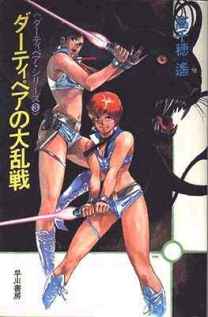 Original Dirty Pair
Original Dirty Pair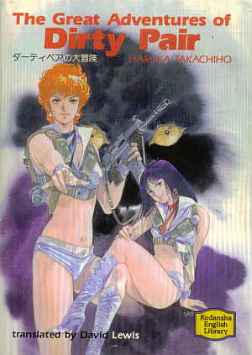 While in English, this came out in Japan, since it was part of a series of translations of popular works, intended as an aid for people learning the language. As a result, the book comes with translation notes at the back explaining, for example, what the phrase “We’re encased in a transparent sheathing of ultrathin reinforced polymer” means. Though I note the word “lesbian” is, apparently, deemed unworthy of further translation. It’s a swift read; discounting the notes, barely 125 pages long, and they’re not large pages either – a lunch-hour might suffice, if your boss gave you a few minutes grace.
While in English, this came out in Japan, since it was part of a series of translations of popular works, intended as an aid for people learning the language. As a result, the book comes with translation notes at the back explaining, for example, what the phrase “We’re encased in a transparent sheathing of ultrathin reinforced polymer” means. Though I note the word “lesbian” is, apparently, deemed unworthy of further translation. It’s a swift read; discounting the notes, barely 125 pages long, and they’re not large pages either – a lunch-hour might suffice, if your boss gave you a few minutes grace.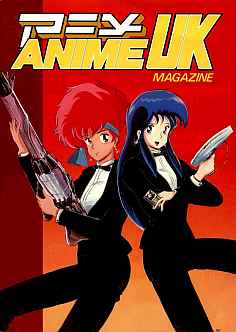 Kei and Yuri’s first appearance on screen was actually an animated cameo in the Crusher Joe movie, in 1983. Reaction to that, and the ongoing series of novels, was positive enough to allow Studio Nue, along with Sunrise Productions, to create a TV series starring the Dirty Pair. Originally slated for a 26-show run, it premiered on July 15th, 1985 and 24 episodes were shown between then and December the same year, with episode titles such as “Chasing the scent of cheesecake and death” and “Don’t be fooled! Love is Russian Roulette”. The remaining two episodes were released as an OAV [Original Animation Videos] entitled From Lovely Angels With Love in January 1987.
Kei and Yuri’s first appearance on screen was actually an animated cameo in the Crusher Joe movie, in 1983. Reaction to that, and the ongoing series of novels, was positive enough to allow Studio Nue, along with Sunrise Productions, to create a TV series starring the Dirty Pair. Originally slated for a 26-show run, it premiered on July 15th, 1985 and 24 episodes were shown between then and December the same year, with episode titles such as “Chasing the scent of cheesecake and death” and “Don’t be fooled! Love is Russian Roulette”. The remaining two episodes were released as an OAV [Original Animation Videos] entitled From Lovely Angels With Love in January 1987.
 A number of the other reviews of this I read were somewhat sniffy and it’s often largely dismissed by DP fans, which surprised the heck out of me, as I though this was, in the main, highly-enjoyable entertainment. The pair are sent to locate a missing girl, who may be tied to a shuttle-crash where the pilot screamed the ground was shifting just before the accident. By the time they arrive, their client is dead, and the girl has holed up in a remote forest, filled with strange life-forms. They’re not the only ones after her either, and I think it’s giving little away to say that the results of the investigation include destruction on industrial levels.
A number of the other reviews of this I read were somewhat sniffy and it’s often largely dismissed by DP fans, which surprised the heck out of me, as I though this was, in the main, highly-enjoyable entertainment. The pair are sent to locate a missing girl, who may be tied to a shuttle-crash where the pilot screamed the ground was shifting just before the accident. By the time they arrive, their client is dead, and the girl has holed up in a remote forest, filled with strange life-forms. They’re not the only ones after her either, and I think it’s giving little away to say that the results of the investigation include destruction on industrial levels.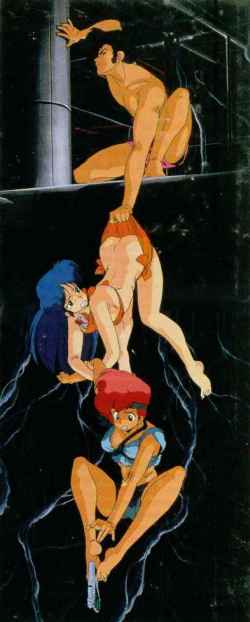 If you’re going to start with Kei and Yuri, this is as good a spot as any; it may not be the first entry in the series, but requires no prior knowledge at all. Even complete novices will be up to speed by the pre-credit sequence, which sees them – oops! – destroying an entire space-station after they decide to pursue the bad guy, rather than handling the explosive suitcase with which he has tried to distract them. They’re then sent to investigate some strange happenings on a mining planet, which is being plagued by attacks from monsters. They discover that the creatures are the results of failed experiments by Dr. Wattsman, who has plans to force nature’s hand, by making the next evolutionary step beyond mankind. Meanwhile, gentlemen thief Carson D. Carson is there, for his own reasons.
If you’re going to start with Kei and Yuri, this is as good a spot as any; it may not be the first entry in the series, but requires no prior knowledge at all. Even complete novices will be up to speed by the pre-credit sequence, which sees them – oops! – destroying an entire space-station after they decide to pursue the bad guy, rather than handling the explosive suitcase with which he has tried to distract them. They’re then sent to investigate some strange happenings on a mining planet, which is being plagued by attacks from monsters. They discover that the creatures are the results of failed experiments by Dr. Wattsman, who has plans to force nature’s hand, by making the next evolutionary step beyond mankind. Meanwhile, gentlemen thief Carson D. Carson is there, for his own reasons.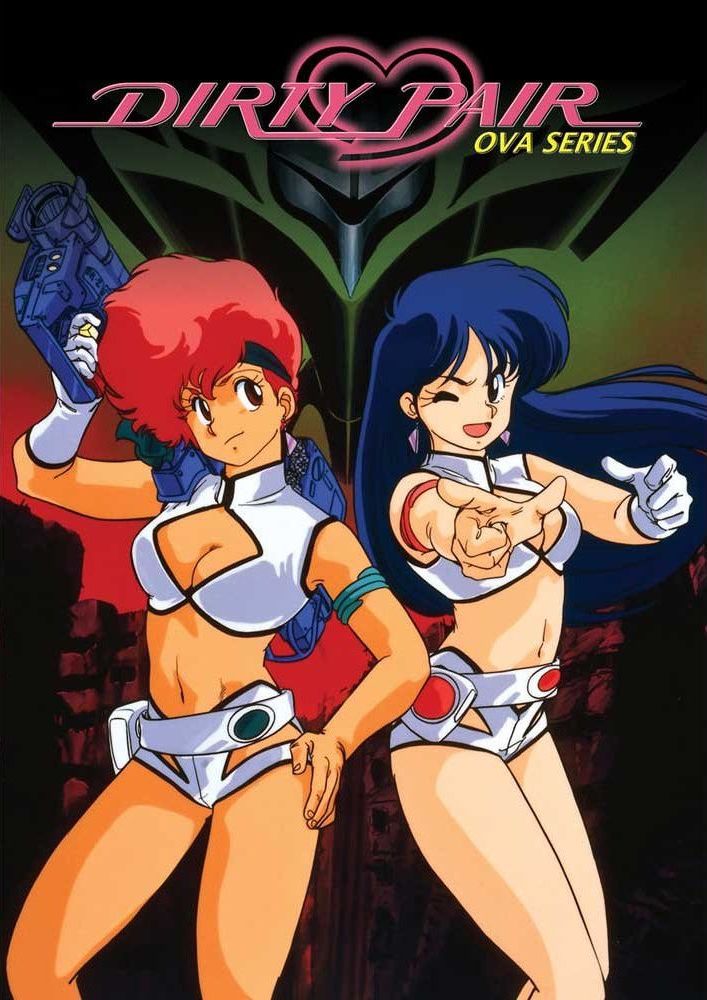
 Why let Kei and Yuri blow up one case, when you can save time by giving them two at once? That’s what happens at the start of this, as the WWWA computer assigns them two, apparently unrelated, assignments in the same galactic sector: one is to investigate a spaceship which blew up, and the other involves the disappearance of a scientist and his family. You will not be surprised to hear that these two cases are interconnected, though it does appear to come as a shock to the participants here. Once they reach their destination, it soon becomes clear that someone is out to stop Kei and Yuri – “someone serious,” to steal a line from Leon. Can they uncover the conspiracy before it uncovers them?
Why let Kei and Yuri blow up one case, when you can save time by giving them two at once? That’s what happens at the start of this, as the WWWA computer assigns them two, apparently unrelated, assignments in the same galactic sector: one is to investigate a spaceship which blew up, and the other involves the disappearance of a scientist and his family. You will not be surprised to hear that these two cases are interconnected, though it does appear to come as a shock to the participants here. Once they reach their destination, it soon becomes clear that someone is out to stop Kei and Yuri – “someone serious,” to steal a line from Leon. Can they uncover the conspiracy before it uncovers them?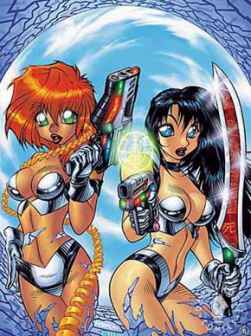 Founded in 1986 out of San Francisco, comic publisher and manga translator Studio Proteus bought the rights to create a new comic version of the Dirty Pair in 1988, the key breakthrough being a direct approach to Takachiho, after the failure of negotiations with Studio Sunrise. There was one requirement, however: the style had to be changed from those already in use. This was agreed to, though there is almost as much evolution from the initial designs through to the most recent version, as between the novels of the Dirty Pair and, say, Dirty Pair Flash. To
Founded in 1986 out of San Francisco, comic publisher and manga translator Studio Proteus bought the rights to create a new comic version of the Dirty Pair in 1988, the key breakthrough being a direct approach to Takachiho, after the failure of negotiations with Studio Sunrise. There was one requirement, however: the style had to be changed from those already in use. This was agreed to, though there is almost as much evolution from the initial designs through to the most recent version, as between the novels of the Dirty Pair and, say, Dirty Pair Flash. To 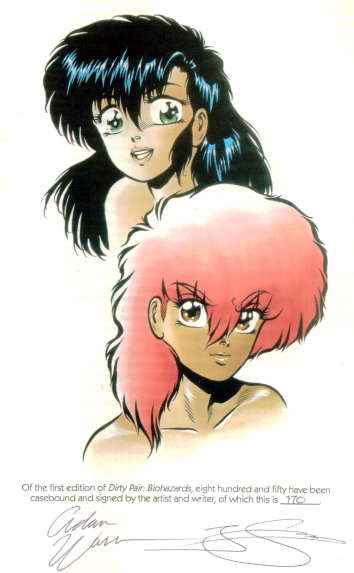 If you thought the novel was a quick read, I got through Biohazards during lunch, and that’s only with 30 minutes. Still, being a comic-book, we must cut it some slack, though I can’t say I find action (and there’s a
If you thought the novel was a quick read, I got through Biohazards during lunch, and that’s only with 30 minutes. Still, being a comic-book, we must cut it some slack, though I can’t say I find action (and there’s a 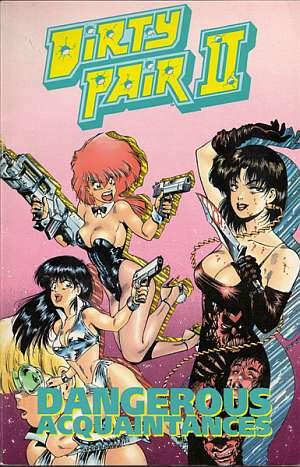 It’s been at least a decade since I read this – probably more – but it is still a thoroughly-enjoyable read, and a major improvement in just about every way (plotting, art, pacing, imagination and characterization) over the first stab. Of particular note is the solid way in which the two separate threads of the story are woven together. While on holiday, Kei and Yuri bump into Shasti, a former colleague of theirs in the WWWA. She was actually an android, who went rogue after a criminal’s personality was implanted into her, part of a (failed) experiment to see if it would help with his capture to have her think like him. She’s now apparently leading a group of “freedom fighters” who are planning to hijack a luxurious space-liner, crammed with VIPs and new technology. Has Shasti gone all political? Or, if not, what is she up to?
It’s been at least a decade since I read this – probably more – but it is still a thoroughly-enjoyable read, and a major improvement in just about every way (plotting, art, pacing, imagination and characterization) over the first stab. Of particular note is the solid way in which the two separate threads of the story are woven together. While on holiday, Kei and Yuri bump into Shasti, a former colleague of theirs in the WWWA. She was actually an android, who went rogue after a criminal’s personality was implanted into her, part of a (failed) experiment to see if it would help with his capture to have her think like him. She’s now apparently leading a group of “freedom fighters” who are planning to hijack a luxurious space-liner, crammed with VIPs and new technology. Has Shasti gone all political? Or, if not, what is she up to? In the mid-1990’s, word began to circulate about a “re-imagining” of the Dirty Pair. This made sense, as the whole world of SF had changed since Takachiho had come up with the idea in the late 1970’s. The future was now a different place, with the likes of Blade Runner and Mad Max having a greater influence than the clean, sleek world shown in films like 2001. The results are darker in tone, though the central characters are, obviously, the same, and the level of mayhem which results from their exploits is equally high. Though watching all the incarnations of the Dirty Pair, the thought strikes me that the depiction, even indirectly, of a huge number of civilian casualties, just isn’t as amusing as it used to be before 9/11…
In the mid-1990’s, word began to circulate about a “re-imagining” of the Dirty Pair. This made sense, as the whole world of SF had changed since Takachiho had come up with the idea in the late 1970’s. The future was now a different place, with the likes of Blade Runner and Mad Max having a greater influence than the clean, sleek world shown in films like 2001. The results are darker in tone, though the central characters are, obviously, the same, and the level of mayhem which results from their exploits is equally high. Though watching all the incarnations of the Dirty Pair, the thought strikes me that the depiction, even indirectly, of a huge number of civilian casualties, just isn’t as amusing as it used to be before 9/11… The surprising thing about this, is that the six episodes, basically, form a single plot, a radically different approach to the first phase anime, where the individual OAVs stood on their own, with little or no ongoing story arc. Here, the parts mesh, starting with the pair, off-duty, coming into possession of an encrypted card, which they must get back to 3WA headquarters, in the face of significant opposition. From this develops the uncovering of a galaxy-wide conspiracy involving the malevolent Lucifer group, which must be foiled, since they have control of galactic communications. However, a significant subplot involves Lady Flair, a sniper who humiliates Kei in the second episode, provoking her into a fury which leads, later on, to our redheaded spitfire quitting the 3WA in order to pursue Flair on her own terms.
The surprising thing about this, is that the six episodes, basically, form a single plot, a radically different approach to the first phase anime, where the individual OAVs stood on their own, with little or no ongoing story arc. Here, the parts mesh, starting with the pair, off-duty, coming into possession of an encrypted card, which they must get back to 3WA headquarters, in the face of significant opposition. From this develops the uncovering of a galaxy-wide conspiracy involving the malevolent Lucifer group, which must be foiled, since they have control of galactic communications. However, a significant subplot involves Lady Flair, a sniper who humiliates Kei in the second episode, provoking her into a fury which leads, later on, to our redheaded spitfire quitting the 3WA in order to pursue Flair on her own terms.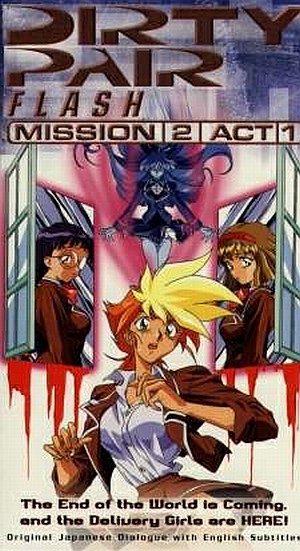 Where are Kei and Yuri, and what have you done with them? That might be the anguished cry of the Dirty Pair fan after watching these five episodes, most of which eschew any efforts at high-octane action, in favour of generally unamusing comedy and tedium. All five parts are set on World’s World, a theme-planet that recreates 20th-century life for tourists. Our heroines are sent there because the computer is virus-infected, to bodyguard the network engineer Touma (Ono) who is going to fix it. Their presence becomes necessary, as it’s soon clear someone is out to stop Touma from doing his job. That only occupies the bookend episodes: the middle three are, while still set on the same planet, largely unconnected. In them, Kei and Yuri must look into ghostly goings-on at a girls’ school, help Touma with his love-life and bring a con-artist to justice.
Where are Kei and Yuri, and what have you done with them? That might be the anguished cry of the Dirty Pair fan after watching these five episodes, most of which eschew any efforts at high-octane action, in favour of generally unamusing comedy and tedium. All five parts are set on World’s World, a theme-planet that recreates 20th-century life for tourists. Our heroines are sent there because the computer is virus-infected, to bodyguard the network engineer Touma (Ono) who is going to fix it. Their presence becomes necessary, as it’s soon clear someone is out to stop Touma from doing his job. That only occupies the bookend episodes: the middle three are, while still set on the same planet, largely unconnected. In them, Kei and Yuri must look into ghostly goings-on at a girls’ school, help Touma with his love-life and bring a con-artist to justice.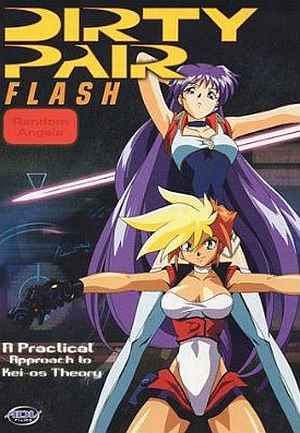 The final – to date – installment of Dirty Pair adventures on the screen, is a bit of a mixed bag. Of the five episodes here, two are pretty good, one mediocre, and two are more than a tad creepy, thanks to the level of, from what I recall of my days in anime, used to be called ‘fan service’. There is an entire episode centered around beach volleyball, which is nothing more than a flimsy excuse to see Kei and Yuri in a variety of miniscule costumes, bordering on the fetishistic. Now, I just don’t find cartoons sexy – no, not even Jessica Rabbit – and given both of them are technically under-age, it all gets a tad sleazy. Things get worse in the fourth episode, when an even younger boy, rich and clever, but very weird, builds a mechanical replica of Yuri and falls in love with it.
The final – to date – installment of Dirty Pair adventures on the screen, is a bit of a mixed bag. Of the five episodes here, two are pretty good, one mediocre, and two are more than a tad creepy, thanks to the level of, from what I recall of my days in anime, used to be called ‘fan service’. There is an entire episode centered around beach volleyball, which is nothing more than a flimsy excuse to see Kei and Yuri in a variety of miniscule costumes, bordering on the fetishistic. Now, I just don’t find cartoons sexy – no, not even Jessica Rabbit – and given both of them are technically under-age, it all gets a tad sleazy. Things get worse in the fourth episode, when an even younger boy, rich and clever, but very weird, builds a mechanical replica of Yuri and falls in love with it.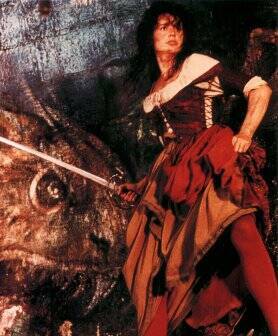 The daughter of Owen “Dubhdarra” (black oak) O’Malley, famous Irish sea captain, is somebody whose life could easily be made into a film. Known as Gráinne Ní Mháille in her native tongue, I suspect the English version, Grace O’Malley, would be a little more manageable for cinemagoers, and so, that’s the form we’ll use here. She was born in 16th-century Ireland, which at the time was largely allowed to operate independently of England. However, during her lifetime, that gradually changed, and it’s this which was behind many of the turning points in her life.
The daughter of Owen “Dubhdarra” (black oak) O’Malley, famous Irish sea captain, is somebody whose life could easily be made into a film. Known as Gráinne Ní Mháille in her native tongue, I suspect the English version, Grace O’Malley, would be a little more manageable for cinemagoers, and so, that’s the form we’ll use here. She was born in 16th-century Ireland, which at the time was largely allowed to operate independently of England. However, during her lifetime, that gradually changed, and it’s this which was behind many of the turning points in her life.
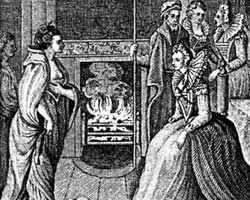 Finally the English Queen agreed and Grace came to court to make her pitch (left). She horrified them by addressing the Queen as an equal – Grace’s use of Latin, the language of nobles, would have impressed the Queen. She made a point of saying that they were much alike, both prepared to fight to keep their possessions. Grace referred to the way Elizabeth had joined her army at Tilbury, when the Spanish Armada threatened to invade in 1588. She made a difference too, as her rousing speech did wonders for the moral of her, up till then, pessimistic troops. [It is historical fact that Elizabeth was fond of hunting, and an excellent shot with a crossbow, so it is possible she may well have got involved if the Spanish had landed.] Around the same time, some Spaniards were shipwrecked in Ireland and slaughtered by Grace. A scene of each of these incidents would help illustrate that they did have a lot in common.
Finally the English Queen agreed and Grace came to court to make her pitch (left). She horrified them by addressing the Queen as an equal – Grace’s use of Latin, the language of nobles, would have impressed the Queen. She made a point of saying that they were much alike, both prepared to fight to keep their possessions. Grace referred to the way Elizabeth had joined her army at Tilbury, when the Spanish Armada threatened to invade in 1588. She made a difference too, as her rousing speech did wonders for the moral of her, up till then, pessimistic troops. [It is historical fact that Elizabeth was fond of hunting, and an excellent shot with a crossbow, so it is possible she may well have got involved if the Spanish had landed.] Around the same time, some Spaniards were shipwrecked in Ireland and slaughtered by Grace. A scene of each of these incidents would help illustrate that they did have a lot in common. Another interesting tale is told about an incident on the way home to Ireland. She stopped at Howth Castle, where hospitality dictated she should have been offered a meal and a place to stay. But she was told the lord was dining, and wasn’t to be disturbed: an infuriated Grace was leaving, when she met the lord’s son, who was returning to the castle. She kidnapped him, and as the terms for his return, demanded that in future, anyone who asked at Howth Castle would get food and a bed. The tradition continues to this day; the family that lives there still has an extra seat for dinner, just in case…
Another interesting tale is told about an incident on the way home to Ireland. She stopped at Howth Castle, where hospitality dictated she should have been offered a meal and a place to stay. But she was told the lord was dining, and wasn’t to be disturbed: an infuriated Grace was leaving, when she met the lord’s son, who was returning to the castle. She kidnapped him, and as the terms for his return, demanded that in future, anyone who asked at Howth Castle would get food and a bed. The tradition continues to this day; the family that lives there still has an extra seat for dinner, just in case… Wrestlemania is the centre of the professional wrestling universe, and the list of women who’ve fought there is like a Hall of Fame for the sport over the past 25 years, with names like Wendi Richter, The Fabulous Moolah, Luna Vachon and Chyna. Wrestlemania XX in 2004 is widely regarded as one of the best ever, and part of that night saw Victoria beating Molly Holly for the women’s title, a result that led to Molly getting her head shaved in the middle of the ring at Madison Square Gardens.
Wrestlemania is the centre of the professional wrestling universe, and the list of women who’ve fought there is like a Hall of Fame for the sport over the past 25 years, with names like Wendi Richter, The Fabulous Moolah, Luna Vachon and Chyna. Wrestlemania XX in 2004 is widely regarded as one of the best ever, and part of that night saw Victoria beating Molly Holly for the women’s title, a result that led to Molly getting her head shaved in the middle of the ring at Madison Square Gardens. Do you miss anything about life in the WWE at all?
Do you miss anything about life in the WWE at all?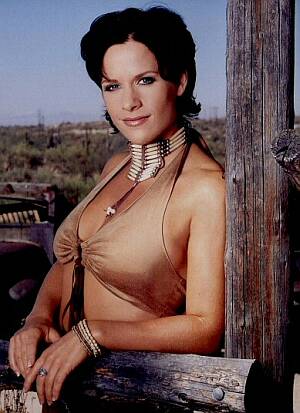 As fans we only see the front-part of the show. Is there anything you were surprised to learn about that goes on behind the scenes?
As fans we only see the front-part of the show. Is there anything you were surprised to learn about that goes on behind the scenes? What did you think when you first saw the Molly Holly action figure?
What did you think when you first saw the Molly Holly action figure? Your Christian faith is an important part of your life, which makes wrestling seem like a strange destination. Did you have any problems reconciling the two?
Your Christian faith is an important part of your life, which makes wrestling seem like a strange destination. Did you have any problems reconciling the two? Looking back, is there anything in your career that you’d do differently if you had the chance over again?
Looking back, is there anything in your career that you’d do differently if you had the chance over again?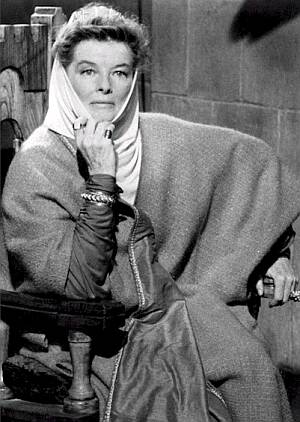 If Eleanor of Aquitaine is perhaps best known through the Oscar-winning portrayal of Katherine Hepburn (right) in The Lion in Winter, she was one of the richest and most powerful women of the Middle Ages in her own right. She was married twice, to the Kings of France and England, and she survived to see two sons also became monarchs. But Eleanor’s own life was both long – she lived into her eighties, remarkable for the era – and colourful.
If Eleanor of Aquitaine is perhaps best known through the Oscar-winning portrayal of Katherine Hepburn (right) in The Lion in Winter, she was one of the richest and most powerful women of the Middle Ages in her own right. She was married twice, to the Kings of France and England, and she survived to see two sons also became monarchs. But Eleanor’s own life was both long – she lived into her eighties, remarkable for the era – and colourful.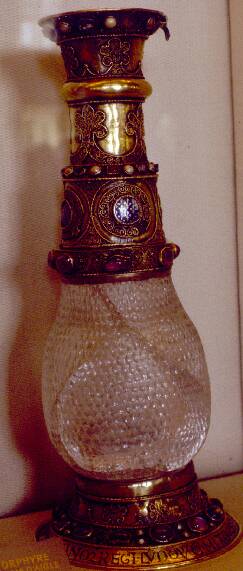
 It was Eleanor who looked after things when he was gone; a contemporary writer, Ralph of Diceto, says: “He issued instructions to the princes of the realm, almost in the style of a general edict, that the queen’s word should be law in all matters.” This is significant, since of Richard’s ten year reign, only six months were actually spent in England. She did make one major overseas trip during this period, arranging for Richard to marry Berengaria of Navarre. But he wasn’t waiting around to get hitched to anyone – he was off to Palestine. It was up to Eleanor, now almost 70, to ride over the Pyrenees, collect the prospective bride from her home, and then travel with her through Spain, France and Italy to Sicily where Richard and his army were camped.
It was Eleanor who looked after things when he was gone; a contemporary writer, Ralph of Diceto, says: “He issued instructions to the princes of the realm, almost in the style of a general edict, that the queen’s word should be law in all matters.” This is significant, since of Richard’s ten year reign, only six months were actually spent in England. She did make one major overseas trip during this period, arranging for Richard to marry Berengaria of Navarre. But he wasn’t waiting around to get hitched to anyone – he was off to Palestine. It was up to Eleanor, now almost 70, to ride over the Pyrenees, collect the prospective bride from her home, and then travel with her through Spain, France and Italy to Sicily where Richard and his army were camped.
 Halder Gomes is a 4th degree black belt and blue belt in Brazilian Jiujitsu. He’s also a graduate in business administration with an MBA in Marketing, from the University of Fortaleza – so he can write your company a plan, then kick your ass if you don’t follow it. :-) However – and undoubtedly of more relevance to our current location, he’s also the director of Sunland Heat, what may be the first locally-produced action-heroine film from Brazil. In between jetting to festivals with his short film Cine Holiúdy – the Good Guy Against the Bad Guy, and attending the American Film Market, he talked to girlswithguns.org about the movie.
Halder Gomes is a 4th degree black belt and blue belt in Brazilian Jiujitsu. He’s also a graduate in business administration with an MBA in Marketing, from the University of Fortaleza – so he can write your company a plan, then kick your ass if you don’t follow it. :-) However – and undoubtedly of more relevance to our current location, he’s also the director of Sunland Heat, what may be the first locally-produced action-heroine film from Brazil. In between jetting to festivals with his short film Cine Holiúdy – the Good Guy Against the Bad Guy, and attending the American Film Market, he talked to girlswithguns.org about the movie. Where did the idea for the film come from?
Where did the idea for the film come from? Why did you decide to have a female lead?
Why did you decide to have a female lead? It was Alex Van Hagen’s first film. Did you have qualms about putting a screen novice in the lead?
It was Alex Van Hagen’s first film. Did you have qualms about putting a screen novice in the lead?

 In Brazil, it was different. When doing post production on Cine Holiúdy, I left a screener at a distributor (Casablanca Filmes), part of the same company as the lab. The film was in their drawer until its premiere in our State film festival. That was a sellout (right): more than 400 people couldn’t get in, causing security problems, and the festival organizers needed other screenings. By coincidence, the distributor’s publisher was there – so were the press and one very respected film critic, Kleber Mendonça Filho, published his review with a headline on the cover of Universo Online, the number one Internet magazine in Brazil. The next day the distributor pulled the film out of their drawer, called me and we made a deal memo. The next week, others did too, including one major distributor.
In Brazil, it was different. When doing post production on Cine Holiúdy, I left a screener at a distributor (Casablanca Filmes), part of the same company as the lab. The film was in their drawer until its premiere in our State film festival. That was a sellout (right): more than 400 people couldn’t get in, causing security problems, and the festival organizers needed other screenings. By coincidence, the distributor’s publisher was there – so were the press and one very respected film critic, Kleber Mendonça Filho, published his review with a headline on the cover of Universo Online, the number one Internet magazine in Brazil. The next day the distributor pulled the film out of their drawer, called me and we made a deal memo. The next week, others did too, including one major distributor.
 Since then, you made Cine Holiúdy – the Good Guy Against the Bad Guy. Why did you decide on a short film rather than another feature?
Since then, you made Cine Holiúdy – the Good Guy Against the Bad Guy. Why did you decide on a short film rather than another feature? This particular lady is one who has come close to being written out of history, and it’s about time she was put back in. It is partly because she is so obscure that I think her movie should be done as a sequel to one on her father, Alfred the Great who, though better known, also deserves more recognition and is definitely worthy of a movie in his own right.
This particular lady is one who has come close to being written out of history, and it’s about time she was put back in. It is partly because she is so obscure that I think her movie should be done as a sequel to one on her father, Alfred the Great who, though better known, also deserves more recognition and is definitely worthy of a movie in his own right. While he got his inspiration from many sources (and did not welcome speculation on such matters!), it is, however, hard to ignore certain similarities between Middle Earth and Anglo Saxon England. For example both had: just one woman to fight on horseback; one woman to lead men in battle; one woman to help rule her people when destiny called. Taking everything into consideration, it is quite likely that the legends of Aethelflaed, Lady of the Mercians, inspired Tolkien to crate Eowyn, Lady of the Rohan (left). I do admit, that this similarity seems to relate more to their character, rather than to the lives they led in fact and fiction.
While he got his inspiration from many sources (and did not welcome speculation on such matters!), it is, however, hard to ignore certain similarities between Middle Earth and Anglo Saxon England. For example both had: just one woman to fight on horseback; one woman to lead men in battle; one woman to help rule her people when destiny called. Taking everything into consideration, it is quite likely that the legends of Aethelflaed, Lady of the Mercians, inspired Tolkien to crate Eowyn, Lady of the Rohan (left). I do admit, that this similarity seems to relate more to their character, rather than to the lives they led in fact and fiction.
 After her husband died in 911, Aethelflaed ruled alone until she died in 918 – he had been sick for some while before this, so in reality she already had the reins. In these last few years she is reported to have led her army in battle against the Vikings, recaptured the town of Derby without a siege, skilfully negotiated treaties with the Danes, Scots and Welsh, and built fortifications – her street plan can still be seen today in the town of Gloucester, where she also rebuilt the Roman walls. Though final victory went to others, without Aethelflaed’s tactical prowess to pave the way, the task of those who followed would have been much harder, if not impossible. [Picture at left is Skeggjold, one of a serious of Valkyrie dolls created by Tanya Van Der Ploeg – for more information visit
After her husband died in 911, Aethelflaed ruled alone until she died in 918 – he had been sick for some while before this, so in reality she already had the reins. In these last few years she is reported to have led her army in battle against the Vikings, recaptured the town of Derby without a siege, skilfully negotiated treaties with the Danes, Scots and Welsh, and built fortifications – her street plan can still be seen today in the town of Gloucester, where she also rebuilt the Roman walls. Though final victory went to others, without Aethelflaed’s tactical prowess to pave the way, the task of those who followed would have been much harder, if not impossible. [Picture at left is Skeggjold, one of a serious of Valkyrie dolls created by Tanya Van Der Ploeg – for more information visit